By Daniel H. Mutibwa
Capacity-building for Leicestershire's cultural and creative businesses and practitioners
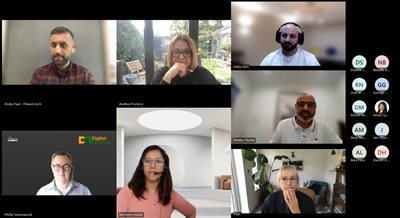 Organisers and attendees getting ready for the start of the webinar.
Organisers and attendees getting ready for the start of the webinar.
On Wednesday 11
th September 2024, the
Leicester and Leicestershire Enterprise Partnership (LLEP) organised an online webinar covering both the existing and potential use of Artificial Intelligence (AI) for individuals, businesses, practitioners, and professionals working in the creative industries. For context, LLEP is an integral part of the
East Midlands Creative Consortium (EMC
2) which is funded by the Department for Digital, Culture, Media and Sport (DCMS) in the context of the
Create Growth Programme. The remit of EMC
2 is to accelerate the growth of creative businesses in the East Midlands. Against this backdrop, the webinar explored current engagement with, and the transformative potential of, AI across various sectors within the creative industries in the East Midlands. Examples included advertising and marketing, crafts, design, film, TV, video, photography, publishing, music, and the performing and visual arts.
Many of the creative practitioners the VCCC project has consulted and engaged with to date have backgrounds in these sectors. It is good to see that those practitioners are being provided with excellent support to enable them to continually build capacity and navigate the constantly changing cultural and creative ecosystem across the county of Leicestershire and the East Midlands. It is also good to see that the webinar was open to individuals with non-creative industries backgrounds and to researchers like myself — with or without backgrounds in the creative industries.
 Nermine Habib (centre in the lower row) offering introductory remarks at the start of the webinar. Andy Paul is left in the upper row.
Nermine Habib (centre in the lower row) offering introductory remarks at the start of the webinar. Andy Paul is left in the upper row.
Nermine Habib (Create Growth Project Manager, Leicester and Leicestershire Business and Skills Partnership) welcomed attendees, introduced the webinar programme, and invited the keynote speaker — Andy Paul (Founder and CEO, Fliweel Tech) — to present.
Following introduction, Andy relayed to attendees that he has worked in the field of data science and consulting for over twelve years in London and San Francisco (US) respectively.
He is routinely invited to speak on AI as it relates to various sectors not just across the creative industries, but a multitude of industries. Cases in point include the retail and legal sectors among others.
In the capacity of expert speaker, Andy offers broader-level AI insights and use cases for organisations. Andy relayed further that Fliweel Tech specialises in four main strands:
- AI Strategy Implementation;
- Robotic Process Automation (RPA);
- Systems Integration; and
- Chatbots and Copilots
AI maturity and its varying uses
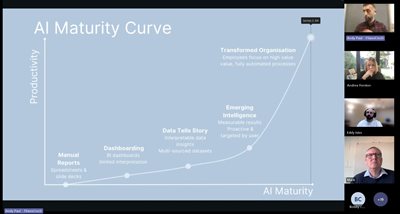
Image depicting the 'AI Maturity Curve' graph discussed by Andy Paul.
It was interesting to learn that as AI has matured, so has its deployment for different uses. Projecting a graph titled ‘AI Maturity Curve’ on the screen, Andy explained that AI has so far undergone five stages during which it has been used to:
- generate manual reports;
- convey different but related information or content in accessible and digestible forms;
- interpret data from numerous sources to tell a story;
- gain valuable insights that can be assessed and measured; and
- support high value, automated processes that substantially transform how an organisation operates.
Of the five stages above, we learnt that AI has been mostly used during the first, three stages. We then learnt about the five common types of AI, namely:
- Robotic Process Automation (RPA) which involves simplifying and automating work processes;
- speech recognition which uses software to convert human speech into text or other machine-readable formats, especially formats that enhance accessibility for people experiencing disabilities;
- vision recognition which uses software to identify people, objects, and places for purposes of verification, learning, and interpretation or analysis;
- data science which involves predicting behaviours and trends, analysing them, and making decisions based on that analysis; and
- generative AI (Gen AI) which encompasses content creation, data simulation, and generation of recommendations.
It was illuminating to learn about some of the uses to which Gen AI has been put in a quest to achieve even more productivity and efficiency. From a legal perspective, for example, Vodafone Group — the British multinational telecommunications company — uses AI to search and understand specific commercial terms and conditions across contracts. The US e-commerce company, Etsy, uses AI to optimise search recommendations and advertisements to deliver better listing suggestions to buyers in a retail context. In an educational and learning context, the Basingstoke College of Technology in Hampshire (England) uses AI to upload study materials and generate a summarised version in several formats, including flash cards and quizzes. It is worth noting that not all of these uses are entirely new. Some of them have, in fact, been in use for quite a while now by some of the dominant global tech companies such as Amazon and Google.
Current AI use in the creative industries
Within the creative industries, we learnt that AI use has revolutionised creativity and productivity in the following sectors:
- in interior design, AI creates 3D layouts and suggests colour schemes tailored to client preferences;
- in creative video production, AI automates video editing tasks for faster, high-quality production. Where audio is recorded, AI enhances audio mixing and enables the creation of new effects;
- in product design, AI optimises prototypes and suggests design improvements;
- in the (visual) arts, AI generates new art styles and expands creative possibilities;
- in advertising and marketing, AI personalises marketing campaigns by analysing consumer data;
- in sound design, AI generates unique soundscapes or music by learning from existing compositions; and
- in (digital) fashion, AI designs digital fabrics and predicts upcoming fashion trends.
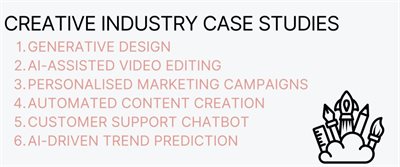
Case uses of AI in selected sectors of the creative industries.
It was illuminating to learn that AI use across the above-named sectors helps to:
- generate innovative solutions;
- optimise processes;
- improve the quality of inputs and outputs;
- reduce costs;
- increase customer satisfaction through improved rate of responsiveness and support; and
- increase revenue.
Taking the example of automated content creation, we learnt that a digital media company that struggles to meet the growing demand for content creation can find itself experiencing slower production times and inconsistent quality. To get back on track, it is critical that the company understands the problem so that it can tackle it effectively and achieve the required outcome. This allows the company to deploy AI in a focused and targeted way — ideally following the multi-stage approach outlined below:
- working towards the outcome of speeding up content creation and maintaining consistency in quality by automating the process of generating text, image, and multimedia content;
- gathering data on content requirements, including topics, keywords, formats, and performance metrics from content generated in the past;
- pre-processing data to identify key content patterns and using AI tools to automate content creation based on set parameters;
- training AI models to predict content trends and generating relevant material, aligning with audience preferences; and
- evaluating automated content performance and refining AI models to maintain high-quality output and relevance.
The promise of AI agents
We then learnt about what the future of AI is shaping up to become — bearing in mind that this space is continually in a state of flux and will continue to be so in the foreseeable future. We heard about what an ‘AI agent’ is and what use it is put to. An ‘AI agent’ is defined and understood as a ‘software entity that employs AI to carry out tasks requiring multiple steps to achieve a specific goal, often automating processes that would normally demand significant human involvement’. We learnt that ‘AI agents’ can be deployed to perform a two-fold function:
- automating complex workflows whereby AI agents can autonomously manage entire workflows unlike simple AI tools that perform singular tasks; and
- enabling customisation and flexibility whereby AI agents combine different AI capabilities to accomplish complex tasks. Examples of AI capabilities include natural language processing, data extraction, and content generation.
For illustration, Andy provided the example of how LinkedIn — the popular business and employment-focused digital platform — deploys AI agents to create, manage, and monitor content, including analysing how users interact with that content. This process is broken down into two main steps, namely content creation and performance monitoring. These two main steps are broadly subdivided into the following substeps:
Content creation
- transcribe and extract: Users provide the AI agent with a YouTube video URL link;
- content configuration: Users select from different types of LinkedIn posts. These could include (1) educational posts, (2) ‘spicy takes’, and (3) 'head-nod posts'. Regarding presentation, the AI agent can apply different writing styles based on user preferences or brand guidelines; and
- first draft generation: The AI agent generates a draft LinkedIn post that fits the selected style and content type. This draft includes engaging elements like (1) quotes, (2) takeaways, and (3) calls to action — all tailored specifically to LinkedIn.
Performance monitoring
- posting and engagement: After the content is posted on LinkedIn, the AI agent tracks performance metrics such as likes, shares, comments, and overall reach;
- data analysis: The AI agent compares the performance of different posts and writing styles, identifying which types of content resonate best with the audience, offering insights into what works well on LinkedIn; and
- feedback and iteration: The AI agent provides feedback based on the collected data. For example, if ‘spicy takes’ outperform other content types, the AI agent may suggest creating more posts in that style. It can also propose variations or improvements for future posts.
The deployment of AI agents in this way is transferable and replicable in virtually all production contexts that involve content creation — irrespective of sector and/or industry. Three main outcomes can be achieved when AI agents are applied in this manner:
- increased reach whereby a greater number of people is targeted;
- efficiency whereby the process of content creation is streamlined — allowing for the rapid production of high-quality posts that perform well; and
- customisation and creativity whereby data-driven recommendations lead to better performance and offer variations for future content.
'All that glitters is not gold' — This applies as much to AI
Despite the clear opportunities and benefits associated with AI use as outlined above, we learnt that AI projects do sometimes fail. Three factors for this failure were given as:
- a lack of trust in AI;
- a lack of skills to implement AI responsibly; and
- a failure to connect AI initiatives with clearly defined business problems.
We learnt further that these risk factors, and others, can be mitigated against. For example, AI-generated content can sometimes feel and sound ‘robotic’. This can be mitigated against by blending such content with a human writing style, tone, and grammar that people can relate to. AI-generated content can sometimes reflect bias, albeit unintentional in nature. Because AI is being used in numerous, different cultural and social contexts across the world, it is imperative that a diverse of range of data reflective of those varied contexts is used to train AI models to counter unintentional bias. It was emphasised that the use of AI is most productive if it is informed by business outcomes first — not data. And just like with many things in life, starting small is always helpful.
For organisations looking to take up AI, starting small might involve the following steps:
- creating an AI squad: assembling a diverse team with knowledge in AI, business processes, and the specific sector/industry within which the organisation is operating. Here, providing training on AI fundamentals, potential applications, and the specific goals the organisation is looking to achieve can very helpful;
- business process analysis: conducting workshops with stakeholders from various departments/units within the organisation to understand existing processes and ‘pain points’. Part of this may involve mapping out workflows and identifying areas where AI could enhance efficiency through reducing costs while adding value;
- use case identification: brainstorming and listing potential AI use cases across different functions. Here, evaluation and prioritisation of each use case could be undertaken — based on feasibility, impact, and alignment with organisational goals; and
- proof of concept: selecting the top-priority use cases for developing proof of concept (PoC) projects. Further steps here could include the validation of PoC results through pilot tests, the gathering of feedback, and the making of necessary adjustments before scaling up.
AI is here to stay — Experimenting with it early and starting small will be critical
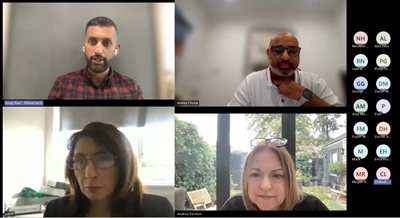
Andy Paul fielding questions during the Q&A session.
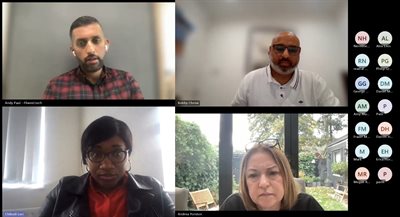
Andy Paul fielding more questions during the Q&A session.
A Q&A session followed. Questions put to Andy ranged from the practical application of AI agents for content creation for creative businesses to first experimentation with Chat GPT to ensuring compliance with legislation (especially intellectual property (IP) and copyright) to identifying appropriate AI tools that drive efficiency and innovation in creative work and associated business processes. A central theme throughout Andy's presentation and the Q&A session was that AI is already playing a significant role in assiting humans in numerous areas of human activity. Andy noted that the anxiety and fear often expressed around AI replacing human capabilities are misplaced. Understanding this means that AI is here to stay just like key inventions such as the Internet. Rather than ignore AI, experimenting with it early by trying out tools as ChatGPT is an important step in the right direction. As AI matures as a technology, uptake may become inevitable in the foreseeable future but doing so by starting small is going to be extremely essential.
Following the Q&A session, Bobby Chotai (Business Development Programme Manager, Enterprise and Business Services, De Montfort University) thanked Andy for his very instructive presentation and pointed attendees in the direction of more events organised in collaboration with the Create Growth Programme mentioned earlier. One event at which Bobby himself will be speaking is the Leicestershire’s Cultural and Creative Future on Monday 30th September 2024.